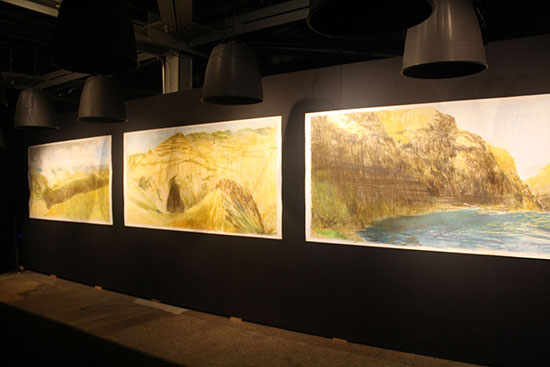For visually impaired people, the world of art can be a challenge. Almost any genre—painting, sculpture, graphics, and photography, to name just a few—demands some degree of sight as the primary sense used to experience it.
The team behind The Oregon Project, a large-scale installation created for the 9e2 festival in Seattle, hopes to change that limitation; they’ve created a piece that allows people who are visually impaired (and those who aren’t) to “hear” a painting. The installation is a perfect example of the kind of tech-infused pieces that are on display at 9e2, a festival that presents art at the intersections of science and technology.
Here’s how it works: four Kinects, motion sensing input devices made by Microsoft for the Xbox 360, allow gallery goers to run their hands across the surface of a two-dimensional drawing or painting and hear a soundscape of the image in front of them. The Kinects, situated in the corners of the room, are able to track visitors’ hand movements and change sounds in relation to the different areas of color, texture or position within the piece that the visitors’ hands are over.
.

"The Oregon Project" with a drawing by Keith Salmon. Photo by Amber Cortes.
.
Artist Keith Salmon, who primarily used pastels to create the images for The Oregon Project, is a Scottish landscape painter with a background in fine arts. Diagnosed with diabetic retinopathy in 1989, he started to slowly lose his vision. Over the years, Salmon was faced with the possibility of losing his livelihood and life’s passion as his sense of sight dwindled.
“I have a small amount of sight in one eye, and in the last few years it has started to deteriorate, and they told me that they can't really operate,” Salmon explained in an interview at King Street Station on October 22, 2016. “So you know, I was thinking about what to do next. I have perhaps three or four years until my sight gets so bad that my drawings and paintings will become so minimal that they start to become irrelevant as pieces of art. And one of the ideas for reinventing my practice was the possibility of using sounds.”
For the installation, Salmon and his team did a residency with the Josephy Center for Arts and Culture in the town of Joseph, Oregon, near an area known as Hell’s Canyon.
.

"The Oregon Project" with drawings by Keith Salmon. Photo by Amber Cortes.
.
“The landscape was phenomenal,” Salmon said. “Suddenly the alpine peaks, in a wall of mountains, just rose above this little town. It was wild, empty, and gorgeous.”
For a few days, Salmon and his team visited different sites with a guide, and while Salmon sketched the landscape, filmmaker Daniel Thornton recorded the sounds around him. Later, in the studio, Salmon perfected his drawings while the team compiled the 54 sounds that would eventually be part of the piece.
The umbras, pale greens, and sky blues of the landscape were matched to recordings made during the residency. In some places, the piece has incorporated the sounds of drawing itself: layered into the soundscape is the scraping of a pencil against paper, or the grinding of chalk, for example.
The project has been funded in part by Microsoft. University of Washington PhD candidate and Microsoft intern Kyle Rector built a “proxemics audio” prototype that sonically interprets images through movement.
Neel Joshi, a researcher at Microsoft who helped develop the project, says the team looked at a number of technologies, like the sense of touch based haptic for example, eventually settling on sound as the perfect medium. Opting not to use headphones, the team set up a series of parabolic speakers instead, to make the installation feel more like a traditional gallery.
“We felt like we wanted something that was a little bit more free-form, where you could explore the art, yet control your experience as well,” Joshi said in a separate interview the same day.
The experience of the piece, according to Salmon, is much like the way a person would experience a landscape, never quite knowing what is around the corner, or over the next hill.
“If there’s one thing I’ve learned from 25 years of losing my vision, it’s that everybody ‘sees’ differently,” Salmon said. “There is this interpretive element, so that if someone like myself who can't see too well comes in, they will get the same experience, but they will also get an interpretive experience too.”
Joshi, who comes from an arts training background, is excited about the potential of new technologies and electronic-based art merging with other, more classical mediums.
“I think we're going to see more merging of everything,” Joshi said, “where it's, you know, a person who will be painting and editing it on their computer, or composing and writing some code, and maybe also just more collaborative projects, too.”
After all, he noted, technology has, in a way, always been a part of the process of making art.
“I have always thought of them as two sides of the same coin,” Joshi said. “I don't really see a big distinction between art and technology, because even in classic arts, there's technology in tools like paints and clay.”
The group plans to exhibit The Oregon Project in Edinburgh, Scotland, in April 2017, and are also looking for ways to turn the project into a toolkit, so that people with visual impairments can use the technology easily, to open up a new world of art, through sound.
__________________________________
Copyright 2016 Hamptons Art Hub LLC. All rights reserved.
